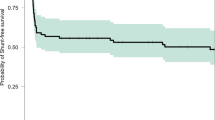Abstract
Twenty-four high-risk newborns with a low birth weight developed progressive hydrocephalus and underwent ventriculoperitoneal shunting (at the time of shunting they weighed 1,100–1,990 g, mean 1,541.5 g). The changes in hydrocephalus after shunting were determined by ultrasound examinations; preoperative examination was by CT. Of the factors evaluated for their relationship to shunt complication, we considered in particular babies with a CSF protein level of over 1.5 g/l (7 cases). These cases were treated with external drainage and later with ventriculoperitoneal shunting. Shunt infections occurred in 20.9%, in contrast with a low incidence of shunt blockage (8.3%), probably owing to previous external shunting in children with high CSF protein. There were 2 deaths (8.3%). All children underwent careful follow-up during the 1st year and serial checkups subsequently for 5 years.
Similar content being viewed by others
References
Bejar R, Curbelo V, Coen RW, Leopold G, James HE, Gluck L (1980) Diagnosis and follow-up of intraventricular and intracerebral hemorrhages by ultrasound studies of infant's brain through the fontanelles and sutures. Pediatrics 66:661–673
Bejar R, Saia S, James HE (1981) Early diagnosis and treatment of posthemorrhagic hydrocephalus in small infants. Pediatr Res 15:650 (abstr)
Boynton BR, Boynton CA, Allen Merritt T, Vaucher YE, James HE, Bejar RF (1986) Ventriculoperitoneal shunts in low birth weight infants with intracranial hemorrhage: neuro-developmental outcome. Neurosurgery 18:141–145
Burstein J, Papile L, Burstein R (1979) Intraventricular hemorrhage and hydrocephalus in premature newborns: a prospective study with the CT. AJR 132:631–635
Chiara A, Pezzotta S, Butti G, Ometto A, Bruschi L, Pietrobono P, Gasparoni MC (1984) Intervento di derivazione liquorale in due neonati prematuri in un reparto di patologia neonatale. In: Rondini G, Ometto A (eds) Patologia cerebrale del neonato. Tipografia del Libro, Pavia, pp 143–146
Frèrebeau P, Guillen M, Privat JM, Benezech J (1982) Non tumoral hydrocephalus in newborns. In: Choux M (ed) Monographs in neurological science, vol 8. Basel, Karger, pp 209–212
Hack M, Fanaroff A, Merkatz I (1979) The low birthweight infant: evolution of a changing outlook. N Engl J Med 301:1162–1165
Hahn YS, McLone DG, Raimondi AJ, Frisbe CL (1983) Surgical outcome of preterm newborns with severe periventricular-intraventricular hemorrhage and post-hemorrhagic hydrocephalus. In: American Society for Pediatric Neurosurgery (eds) Concepts in pediatric neurosurgery IV. Basel, Karger, pp 66–80
James HE, Walsh JW, Wilson HD, Connor JD, Bean JR, Tibbs PA (1980) Prospective randomized study of therapy in cerebrospinal fluid shunt infection. Neurosurgery 7:459–463
James HE, Bejar R, Merritt A, Gluck L, Coen R, Mannino F (1984) Management of hydrocephalus secondary to intracranial hemorrhage in the high risk newborn. Neurosurgery 14:612–618
James HE, Bejar R, Gluck L, Coen R, Merritt A, Mannino F, Bromberger P, Saunders B, Schneider H (1984) Ventriculoperitoneal shunts in high risk newborns wheighing under 2,000 grams: a clinical report. Neurosurgery 15:198–202
Krishnamoorthy K, Shannon D, DeLong G, Todres ID, Davis KR (1979) Neurologic sequelae in the survivors of neonatal intraventricular hemorrhage. Pediatrics 64:233–237
Marlin AE (1980) Protection of the cortical mantle in premature infants with posthemorrhagic hydrocephalus. Neurosurgery 7:464–468
Papile LA, Burstein J, Burstein R, Koffler H (1978) Incidence and evolution of subependymal and intraventricular hemorrhage: a study of infants with birth weights less than 1,500 grams. J Pediatr 92:529–534
Papile LA, Munsick-Bruno G, Schaefer A (1983) Relationship of cerebral intraventricular hemorrhage and early childhood neurologic handicap. J Pediatr 103:273–277
Quinn RJM, Adhikari M (1978) Compressive head-wrapping for hydrocephalus in premature infants. Clin Pediatr (Phila) 17:464–466
Scarff TB, Anderson DE, Anderson CL, Caldwell CC (1983) Complications of ventriculoperitoneal shunts in premature infants. In: American Society for Pediatric Neurosurgery (eds) Concepts in pediatric neurosurgery IV. Basel, Karger, pp 81–99
Stewart AL, Turcan DM, Rawlings G, Reynolds EOR (1977) Prognosis for infants weighing 1,000 g or less at birth. Arch Dis Child 52:97–104
Author information
Authors and Affiliations
Rights and permissions
About this article
Cite this article
Pezzotta, S., Locatelli, D., Bonfanti, N. et al. Shunt in high-risk newborns. Child's Nerv Syst 3, 114–116 (1987). https://doi.org/10.1007/BF00271137
Issue Date:
DOI: https://doi.org/10.1007/BF00271137




